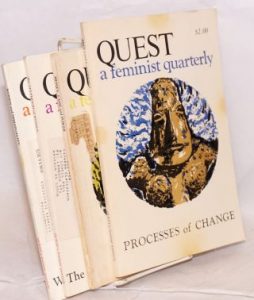I sincerely encourage PhD candidates to try to understand and sincerely answer this question of how using socialism fared in a predominantly capitalist society for articulating change.
The reason the socialist message was effectively communicated through a periodical such as Quest, a feminist periodical, was due to the reader base of the periodical. What does that mean, a reader base? Well when I consider what a typical Playboy reader looks like I imagine a white man who works some white collar job. The advertisements in Playboy would make sense for this type of reader base: golf clubs, liquor, cigarettes, naked women scattered through all of the pages- that seems reasonable for white men. When I consider what a Quest reader looks like I imagine a woman (not necessarily white!, and it could be a man who identifies as an ally!) who is trying to further their role for social change and consciousness. Once again, these advertisements in Quest and Conditions make sense: the advertisements they used were on poetry about women, writings on black women in the south, writings on women in prison, writings on socialism, etc.
The fundamental difference in these advertisements is based in their materialistic value. For a Playboy reader a golf club that is being advertised might be worth every penny and some poetry might be worth nothing to them. For a Conditions reader a book of poems may be worth every penny to them and the golf clubs nothing. While both of these objects may be bought for their advertised price, I argue that because the feminist base is supporting a movement bigger than themselves, they are willing to buy goods and services even if they can’t maximize their utility as consumers. Simply put, if a man didn’t think they would enjoy a round of golf, they probably wouldn’t buy the golf clubs. However, I believe that the feminist base is more likely to buy publications that they aren’t necessarily excited about because they know that their financial contribution makes a lasting impact for a movement they want to see succeed.
More simply, this means that if golf clubs are being sold for $50 and you are willing to pay $50 because you value them at that price- you buy them. If they cost more than your willingness to pay then you forgo buying them. However, if you’re a feminist and you see that a book of poems that are being sold for $3.50, your willingness to pay may be higher than normal because you are investing into something that has social impact and is aligned with your values.
So how did socialist advertisement effectively communicate their message and not go bankrupt in a capitalist environment? They had readers like Jan Clausen who wanted to make a social impact and pay more than what might be considered normal when compared to Playboy consumers. ?




